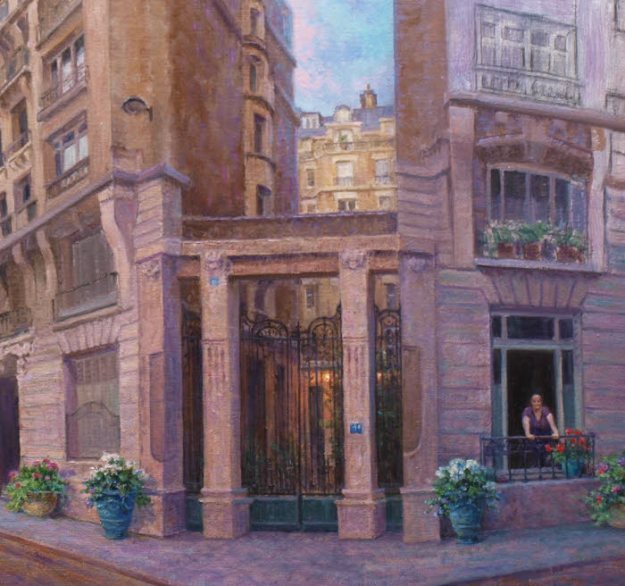In this blog post I decided to talk about oil painting composition, critiquing a critique.
While researching the subject, I came across a respected artist and author who was using works by other artists as examples where composition mistakes had been made. The artist/author then suggested solutions for improvement and did so by modifying the image.
Respectfully, the author did not include the artist’s name to which he was critiquing. However, one example caught my attention.The painting being critiqued was done by an all time favorite master artist named Clark Hulings! I recognized it from a 1999 show catalog that I have.
WHAT’S WRONG WITH THE PAINTING? (Nothing as you will see)
This is the Hulings painting cited as an example whereby a painting composition “rule” was broken.
The so called “rule” was avoiding strong geometric shapes, even if naturally occurring as they can be too distracting.
A strong triangular shape produced by the apparent shadow of a building at the bottom of Hulings painting was the culprit. I agree with the rule to an extent, but everything in a composition is relative to the artist’s vision and even if some supposed rule is broken, yet it serves a legitimate purpose, so be it.
A Composition Improvement? Maybe not
Here’s the modified version suggested by the artist/author which was recreated. The suggested improvement was variegating the shadow, thus breaking up the geometric triangular form.
Is this really an improvement? Here’s my analysis.
Critiquing the Critique
Let’s take a look at the shadow without the chicken along the left side of the triangular shape and the scattered darks near the back edge.
Obviously the shadow overwhelms the painting and your eye drops to it. However, Hulings did two things. First, he added the chicken and broke the line. Secondly, by adding the scattered darks near the edge of the canvas he softened the line and kept your eye from exiting at that point. Obviously, Hulings was aware of the geometric shape.
The goat milk vendor is the obvious focal area. In the so called improvement, the eye now drops and travels in sort of a merry-go-round fashion.
This is not necessarily a bad thing. However, in Hulings original painting the eye stays at the focal area, held in place by the arrow formed by the shadow which lines up and points to the center of action.
It’s true that no artist is free from making mistakes, however, my conclusion is that Hulings was too much of a master painter and in this instance, he deliberately kept the painting as it was to fix your attention on the primary subject.
In Conclusion
The story of the painting is clearly about the goat milk vendor who takes his goat and instead of delivering the milk in bottles, the householder comes and offers a pan and the vendor milks the goat on the spot. How’s that for fresh?
Everything else in the composition is subordinate to the story and the focal area of action. Hulings didn’t make a mistake. He kept that strong shape for a legitimate reason. He used it to make you look where he wanted you to look. So to repeat: Everything in a oil painting composition is relative to the artist’s vision and even if some supposed rule is broken, yet it serves a legitimate purpose, so be it.





























